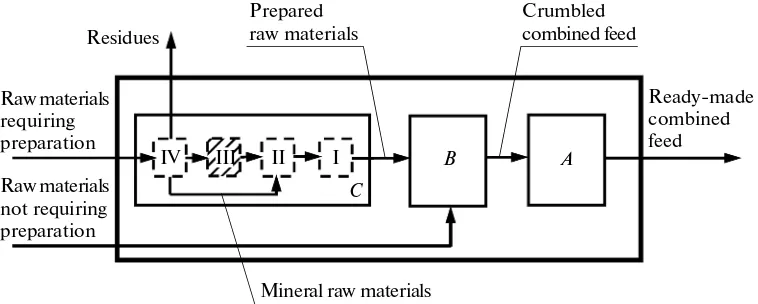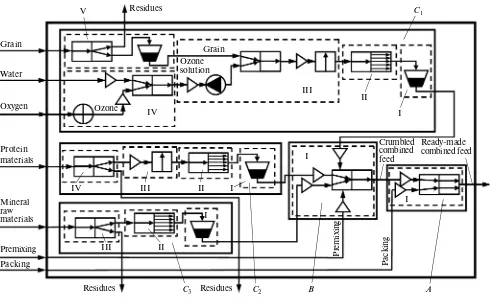ISSN 1068-3674, Russian Agricultural Sciences, 2015, Vol. 41, No. 6, pp. 494–497. © Allerton Press, Inc., 2015.
Original Russian Text © S.V. Braginets, O.N. Bakhchevnikov, 2015, published in Doklady Rossiiskoi Akademii Sel’skokhozyaistvennykh Nauk, 2015, No. 5, pp. 64–67.
494 Today, the organization of efficient on-farm pro-duction of all-in-one combined feed based on local raw materials still remains a topical issue. What impedes their efficient use is their contamination with microscopic mold fungi and their hazardous byprod-ucts, i.e., mycotoxins. In particular, the share of sam-ples with excessive MPC of mycotoxins in the total number of combined feed samples taken in the south-ern regions of Russia is approximately 80%, and the share of positive samples is 100% [1]. The reason for this is contamination of vegetation feed components during cultivation and storage [1, 2]. The most con-taminated components are cereal grain and oil plant cakes and coarse meal. Today, combined feed compo-nents are not disinfected at on-farm combined feed production facilities with a capacity of up to 3 t/h. Thus their feed output does not meet biological safety requirements. In addition, contamination of com-bined feed with mold fungi cuts its storage life.
Since 2010, the Northern-Caucasian Scientific Research Institute of Mechanization and Electrifica-tion of Agriculture (NCSRIMEA) has conducted studies to determine the most efficient methods of grain disinfection. It has been found that pathogenic flora is efficiently destroyed by microwave radiation, in ozone solution, and in alkaline water [2]. However, the strongest effect is produced by the joint action of microwave radiation and ozonized or alkaline electro-lyzed water [2, 3]. Their joint impact produces a syn-ergetic effect, destroying 95% of bacteria and up to 80% of mold fungi and their spores, while technologi-cal properties of grain and feed are retained. It has been found that the most efficient algorithm is to
pro-cess the grain in an active liquid and then expose the moistened grain to microwave radiation [3, 4]. Oil plant cakes and coarse meal are efficiently disinfected by microwave radiation [5].
To translate the validated methods of disinfection into action, experts at the NCSRIMEA have devel-oped respective technical tools [6, 7] and an assembly to disinfect grain with active liquids. This unit is a hor-izontal blade-paddle mixer, where ozone water solu-tion or electrolyzed alkaline water is supplied via a sys-tem of nozzle and flow-regulating valves with the help of a pump [6]. The active liquid is sprayed onto the surface of the mixed grain. The ozone water solution is prepared by flowing the gas produced in the ozonizer through the water in the bubbler. The alkaline water is produced in an EAP-03 electric activating unit. The bulky components of the feed are exposed to the con-vective microwave action produced by a Sigma-1 microwave assembly, which leads to destruction of microorganisms [7].
It is, therefore, a topical problem to include the disinfection of the most affected components, i.e., fodder grain, oil plant cakes, and coarse meal, in the process flow scheme of on-farm combined feed pro-duction. Consequently, it is necessary to determine the position of these operations in the process flow. At the same time, the integrity of the existing production– engineering scheme shall be maintained without over-sophistication.
Organizational Features of Process Flow of Combined Feed
Production with Disinfection of Raw Materials
S. V. Braginets and O. N. Bakhchevnikov
Northern-Caucasian Scientific Research Institute of Mechanization and Electrification of Agriculture, Zernograd, Rostov oblast, 347740 Russia
e-mail: sbraginets@mail.ru
Received May 20, 2015
Abstract—The problem of including disinfection of combined feed components with active liquids and microwave radiation in the process flow scheme of on-farm combined feed production is considered. The elaborated operator model helps define the position of disinfection operations in the combined feed produc-tion system. The raproduc-tional management of the processing line of combined feed producproduc-tion is validated.
Keywords: combined feed, disinfection, microwave radiation, ozone solution, biological safety of feed DOI: 10.3103/S106836741506004X
RUSSIAN AGRICULTURAL SCIENCES Vol. 41 No. 6 2015
ORGANIZATIONAL FEATURES OF PROCESS FLOW OF COMBINED FEED PRODUCTION 495
METHODS
The provisions of the food production process flow theory were used [8]. In particular, the operator model of the on-farm combined feed production system was elaborated. In this model, the production system is given as a sum of single-operation subsystems. These operations are operators with a set of physical cesses, i.e., processors interconnected by flows of pro-cessed raw materials. The experimental data were used to determine the stability of the subsystems, including the disinfection operations and the integrity level of the whole system.
RESULTS AND DISCUSSION
A typical combined feed production system includes raw materials preparation subsystem C, crumbled combined feed production (component dis-pensing and mixing) subsystem B, and ready-made combined feed production subsystem A (Fig. 1). Dis-infection of ready-made combined feed (subsystem A) is unreasonable, because it leads to excessive con-sumption of electricity and other resources. It is opti-mal to disinfect raw materials in the preparatory phase (subsystem C), which shall be done only to raw mate-rials with the highest pathogenic flora content, i.e., only to grain and protein components (oil plant cakes and coarse meal). As a result, cost-efficient use of resources will be ensured. To make the disinfection operations more efficient, the processed components of the feed shall undergo preliminary peeling [3, 4]. It is, therefore, reasonable to perform disinfection oper-ations III as part of subsystem the preparatory phase C after fractional separation and peeling in phase IV and before grinding in phase II.
Raw materials requiring preliminary preparation are divided into three groups: grain components are disinfected with active liquid and microwave radia-tion, protein components are disinfected with micro-wave radiation, and mineral components do not require any disinfection at all. In this respect, it is rea-sonable for the synthesis of the combined feed produc-tion system to divide subsystem C into three sub-systems: C1 is the grain component preparation sub-system, C2 is the protein component preparation subsystem, and C3 is the mineral component prepara-tion subsystem.
In Fig. 2, the operator model of the combined feed production system is presented. In this model, disin-fection operations do not form a separate subsystem but are included into subsystem C, i.e., technological flows of raw materials are not interrupted in the course of processing. Thus, the disinfected raw materials are supplied to central subsystem B (dispensing and mix-ing phase), which makes it possible to produce biolog-ically safe feed.
In 2012–2013, a fragment of the process line cor-responding to the elaborated operator model was orga-nized in the Rostov oblast by Svetloe Vremya AGRO corporation. The experimental data on the use of that fragment was used to estimate the operational stability of particular subsystems (ηi) according to equation (1):
(1) where Hi and Hmax are the entropy of the ith subsystem and the maximum entropy, respectively. All the sys-tems involved in combined feed production are binary. In other words, either high-quality or poor-quality feed is produced. For this reason, the MPC of mold fungi content in combined feed was used as the factor of merit.
496
RUSSIAN AGRICULTURAL SCIENCES Vol. 41 No. 6 2015
BRAGINETS, BAKHCHEVNIKOV
Integrity ΘCBA of the processing system of
sub-systems A, B, and C is determined according to equa-tion (2):
(2) and the stability of subsystem C, consisting of statisti-cally autonomous subsystems C1, C2, and C3, is deter-mined according to the following equation:
(3) Taking account of (3), equation (2) will be recorded as (4) According to (4), the integrity of the combined feed production system, including operations of raw materials disinfection, is ΘCBA = 0.7 > 0. In terms of
integrity, the processing system belongs, therefore, to the domain of integral systems, which points at its high-quality organization.
ΘCBA = ηC+ηB/C+ηA/CB,
ηC = ηC3C2C1 = ηC3+ηC2+ηC1–2.
ΘCBA = ηC3+ηC2+ηC1+ηB/C3C2C1+ηA/C3C2C1B–4.
The suggested scheme of organizing the process flow of on-farm combined feed production with disin-fection operations can be characterized as sustainable and does not have any negative impact on the system’s stability. Although the inclusion of additional opera-tors in its subsystems makes the considered system somewhat more complex, this is compensated by the significantly improved quality of ready-made com-bined feed. The hardware-and-machinery structure of the respective processing line was validated and devel-oped on the basis of the operator model of the consid-ered system. The suggested technological solutions can encourage efficient integration of disinfection operations with already functioning on-farm facilities and facilities in the course of design. As a result, the quality and biological safety of combined feed output and farming products will be very much improved.
Residues
Fig. 2. Operator model of the on-farm combined feed production system, including disinfection of raw materials: A is the sub-system of ready-made combined feed production, including operator I, which is combined feed packing; B is the subsub-system of crumbled combined feed production, including operator I, which is component dispensing and mixing; C1 is the subsystem of
grain components preparation, including operator I, which is intermediate storage of prepared grain, operator II, which is grain grinding, operator III, which is grain disinfection, operator IV, which is ozone solution production, and operator V, which is grain separation; C2 is the subsystem of protein components preparation, including operator I, which is intermediate storage of
pre-pared raw materials, operator II, which is raw materials grinding, operator III, which is raw materials disinfection, operator IV, which is fractional separation of raw materials; C3 is the subsystem of mineral components preparation, including operator I,
RUSSIAN AGRICULTURAL SCIENCES Vol. 41 No. 6 2015
ORGANIZATIONAL FEATURES OF PROCESS FLOW OF COMBINED FEED PRODUCTION 497
REFERENCES
1. Kovalenko, A., Soldatenko, N., Fetisov, L., and Sukhikh, E., Mycotoxicological monitoring of feed in the North Caucasus region, Kombikorma, 2011, no. 3, pp. 98–99.
2. Pakhomov, V.I., Pakhomov, A.I., and Maksimenko, V.A., Experimental analysis of the combined methods of dis-infecting of grain, Mater. Mezhd. agroekologicheskogo foruma: v 3 t. (Proc. Int. Agroecological Forum: in 3 vols.), St. Petersburg, 2013, vol. 2, pp. 230–235. 3. Fisinin, V.I., Lachuga, Yu.F., Pakhomov, V.I.,
Pakho-mov, A.I., and Bukhantsov, K.N., RF Patent RU 2550479, 2015.
4. Bukhantsov, K.N., Mathematical model of disinfecting of wet grain by combination of convection heating and
treatment with the electromagnetic field of ultrahigh frequency, Elektrotekh. Kompleksy Sist. Uprav., 2015, no. 1 (37), pp. 9–23.
5. Egorova, E.Yu. and Batashova, N.V., The effectiveness of physical methods of decontamination of oil cakes,
Masla Zhiry, 2010, no. 7-8, pp. 24–27.
6. Pakhomov, V.I., Alferov, A.S., Smolenskii, A.V., and Mikhailov, V.A., RF Patent RU 123346, 2012.
7. Pakhomov, V.I., Pakhomov, A.I., and Maksimenko, V.A., RF Patent RU 134726, 2013.
8. Panfilov, V.A., Teoriya tekhnologicheskogo potoka (Pro-cess Flow Theory), Moscow: KolosS, 2007.

